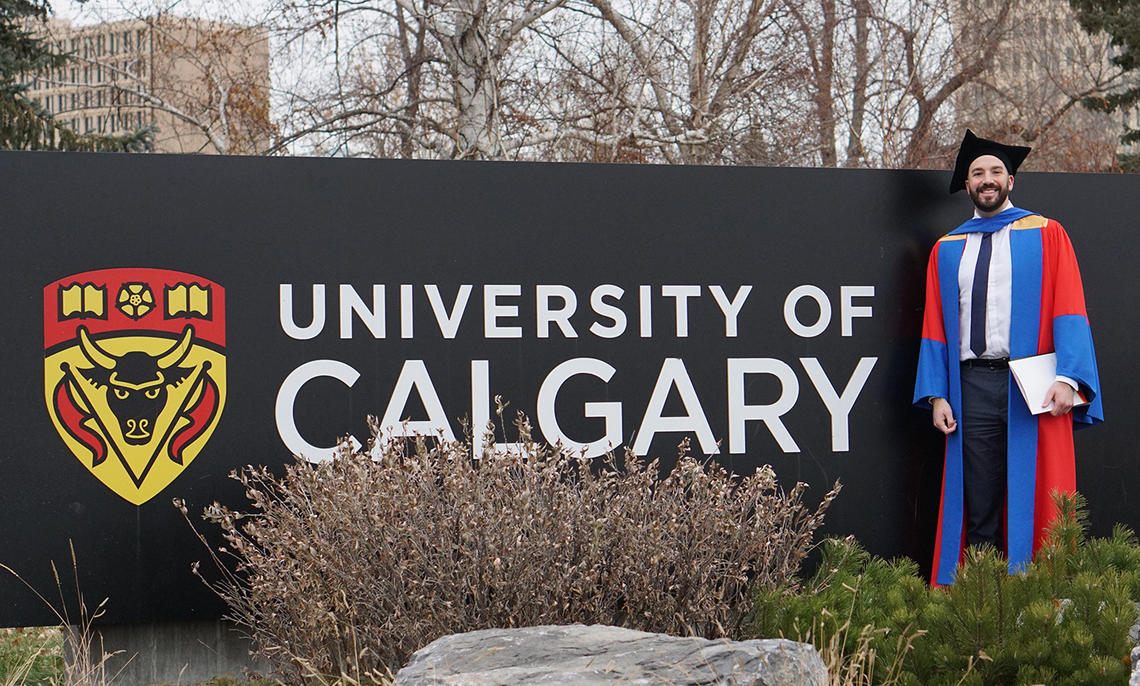Dec. 3, 2019
Class of 2019: Students envision practical, low-carbon ways to build cities
The design, construction and operation of buildings account for nearly 40 per cent of the world’s energy-related carbon emissions. During this year’s Global Climate Strike, the Canadian design industry publicly committed to eliminating waste and harm to the environment. Part of this commitment included support for a shift to circular design: mimicking natural ecosystems in our man-made systems in a bid to eliminate waste.
Four postgraduate students at the University of Calgary kept sustainability top of mind as they carried out their final research projects. Working with design studios such as 3XN/GXN, Dialog Design, McKinley Burkhart, and Studio North, the newest alumni of the School of Architecture, Planning and Landscape (SAPL) provide practical insight into how design and planning can be deployed to reduce overall carbon impact.
Seyi Arole, Kristen Forward and Hayden Pattullo graduated with Master of Environmental Design (MEDes) degrees as part of the Mitacs Accelerate program. Waste and sustainability were primary considerations as all three refined their research projects with respective MITACS partners under the theme of Designing Out Waste.

Rylan Graham.
Courtesy Rylan Graham
Creating a procedural passport for buildings
Arole’s research focused on creating a procedural passport that would take all the information developed at the initial phase of a building’s construction, maintain it and make it available at the end of its life.
“Buildings outlive the people who designed or engineered them,” he explains, hence the need for a system for “tracking construction materials and keeping them out of the waste-stream. At the end of its life, you want to be able to reuse a building’s materials.”
His inspiration for the research began with a Laboratory for Integrative Design workshop where participants used digital tools to produce a lamp with hundreds of variations. Arole saw an opportunity to scale up the processes and apply them to modular building components.
Most buildings are not adaptable over time. By using computational/parametric tools and applying them to create modules that can be taken apart for reconfiguration, buildings can be adapted and evolve with time.

Seyi Arole.
School of Architecture, Planning and Landscape
Reducing energy use through 3D printing
Pattullo focused his research around how to make wasteful space useful, or profitable, as well as how to use algorithms to affect design (parametric design). He also looked at introducing greater efficiency into the design-build process by using 3D printing over traditional methods.
3D printing reduces the amount of energy used in manufacturing because components are made of one material, which is easier to reuse and can be labeled and sorted. Parts manufactured using traditional methods are generally a composite of several materials, more time-consuming to put together and less likely to be reused eventually. Traditional methods are “limited to what you can build at 90-degree angle corners,” he explains.
Cooling accounts for a significant portion of the energy cost associated with buildings and is trending upwards. Pattullo interned at Dialog Design during his degree, working with a team to create high-performance building facades to dramatically decrease energy used in cooling buildings.

Hayden Pattullo
School of Architecture, Planning and Landscape
Delivering beauty with performance
Forward developed research on how the aesthetics of sustainable/recyclable materials can be integrated into building practice.
During the first summer of the MEDes program, she had an opportunity to work with Danish architect Kasper Guldager Jensen, who is a big proponent of circular design: “reducing or eliminating waste in design by reusing materials, permitting adaptation, and efficiently managing energy consumption,” she explains.
Jensen showed her the possibilities for using digital tools to make sustainability sexy, which was a welcome departure from the aesthetically dry work the field had produced over the years.
A representative from Nike, after hearing Forward present her research at the International Association for Computer Aided Design in Architecture (ACADIA) conference in Austin, expressed interest in connecting her work to their research in 3D printing shoe designs using recycled shoes.

Kristen Forward.
School of Architecture, Planning and Landscape
Uncovering barriers to smart growth
Between 1990 and 2010, Smart Growth was at the forefront of city planning conversations. Rylan Graham completed his PhD in Planning, researching growth patterns during these 20 years for evidence of the impact smart growth might have had on mid-size Canadian cities (those with populations between 50,000 and 500,000).
He found that, despite their best intentions, mid-size cities were more challenged than large cities to grow up versus out, because the negative impacts of sprawl were not as apparent. Sprawl is a costly endeavour that inevitably results in infrastructure debt, segregated building use (commercial versus residential), car-dependency and the need for more services and more roads. It is “unsustainable from economic, social and environmental perspectives,” he explains.
Graham is currently working on a post-doctoral fellowship where he will continue his research as well as teach. He wants to challenge and enable future students to wrestle with big questions and ideas.





